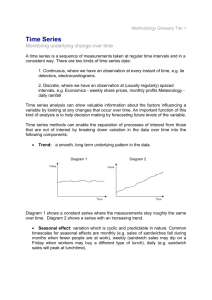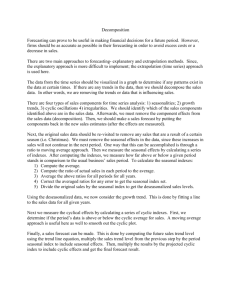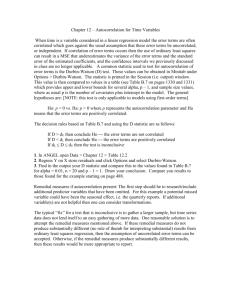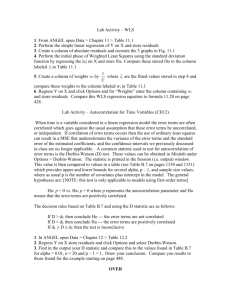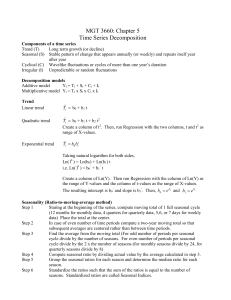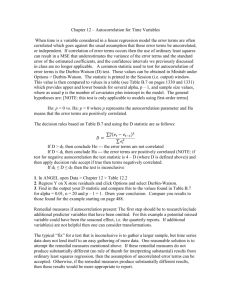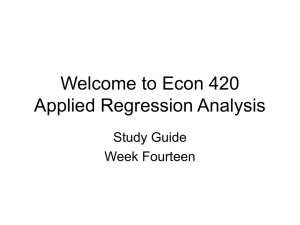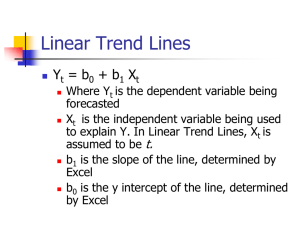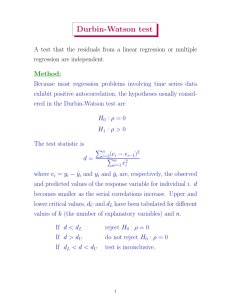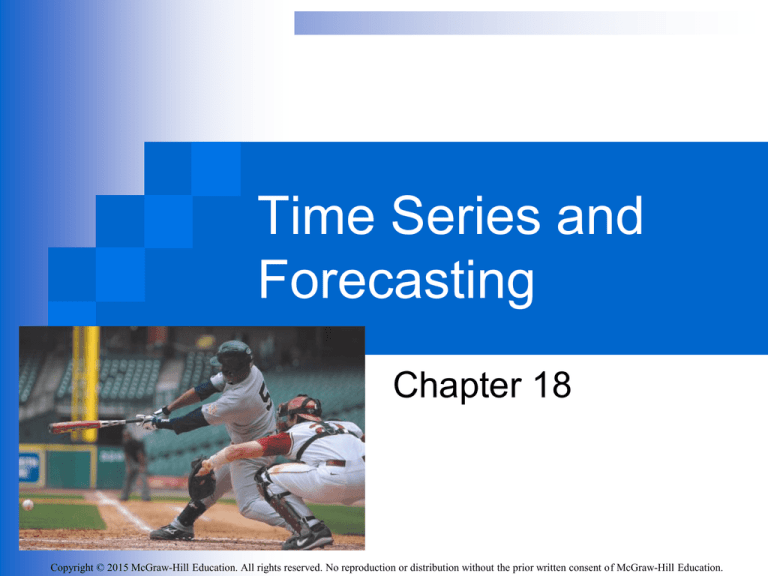
Time Series and
Forecasting
Chapter 18
Copyright © 2015 McGraw-Hill Education. All rights reserved. No reproduction or distribution without the prior written consent of McGraw-Hill Education.
Learning Objectives
LO18-1 Define and describe the components of a time series.
LO18-2 Smooth a time series by computing a moving average.
LO18-3 Smooth a time series by computing a weighted
moving average.
LO18-4 Use regression analysis to fit a linear trend line to a
time series.
LO18-5 Use regression analysis to fit a nonlinear time series.
LO18-6 Compute and apply seasonal indexes to make
seasonally adjusted forecasts.
LO18-7 Deseasonalize a time series using seasonal indexes.
LO18-8 Conduct a hypothesis test of autocorrelation.
18-2
LO18-1 Define and describe the
components of a time series.
Time Series and its Components
A TIME SERIES is a collection of data recorded over a period of time
(weekly, monthly, or quarterly), that can be used by management to compute
forecasts as input to planning and decision making. It usually assumes past
patterns will continue into the future.
Components of a Time Series
Secular Trend – the smooth long term direction of a time series
Cyclical Variation – the rise and fall of a time series over periods longer than
one year
Seasonal Variation – Patterns of change in a time series within a year which
tends to repeat each year
Irregular Variation – classified into:
Episodic – unpredictable but identifiable
Residual – also called chance fluctuation and unidentifiable
18-3
LO18-1
Secular Trend – Example
18-4
LO18-1
Cyclical Variation – Sample Chart
18-5
LO18-1
Seasonal Variation – Sample
Chart
18-6
LO18-1
Irregular variation
Behavior of a time series other than trend
cycle or seasonal.
Subdivided into:
Episodic.
Residual.
Also known as forecasting error.
18-7
LO18-2 Smooth a time series by
computing a moving average.
The Moving Average Method
Useful in smoothing time series to see its
trend.
Basic method used in measuring seasonal
fluctuation.
Applicable when a time series follows a
fairly linear trend.
18-8
LO18-2
Moving Average Method - Example
18-9
LO18-2
3-year and 5-Year Moving Averages:
Example
18-10
LO18-3 Smooth a time series by computing
a weighted moving average.
Weighted Moving Average
A simple moving average assigns the same
weight to each observation in the averages.
Weighted moving average assigns different
weights to each observation in the average.
Most recent observations receive the most
weight, and the weight decreases for older data
values.
We assign the weights so that the sum of the
weights = 1.
18-11
LO18-3
Weighted Moving Average Example
Cedar Fair operates seven amusement parks
and five separately gated water parks. Its
combined attendance (in thousands) for the
last 20 years is given in the following table. A
partner asks you to study the trend in
attendance. Compute a three-year moving
average and a three-year weighted moving
average with weights of 0.2, 0.3, and 0.5 for
successive years.
18-12
LO18-3
Smoothing with a Weighted Moving
Average - Example
18-13
LO18-3
Smoothing with a Weighted Moving
Average - Example
18-14
LO18-4 Use regression analysis to fit a
linear trend line to a time series
Linear Trend
The long term trend of a time series may approximate
a straight line.
18-15
LO18-4
Linear Trend Plot
18-16
LO18-4
Linear Trend – Using the Least
Squares Method, Regression
Analysis, and Excel
Use the least squares method in Simple
Linear Regression (Chapter 13) to find the
best linear relationship between 2 variables
Code time (t) and use it as the independent
variable. That is, let t be 1 for the first year, 2
for the second, and so on.
18-17
LO18-4
Linear Trend – Using the Least
Squares Method, Regression
Analysis, and Excel
18-18
LO18-4
Linear Trend – Using the Least Squares
Method, Regression Analysis, and Excel
18-19
LO18-5 Use regression analysis
to fit a nonlinear time series.
Nonlinear Trend – Using
Regression Analysis and Excel
A linear trend equation is used when the data are
increasing (or decreasing) by equal amounts.
A nonlinear trend equation is used when the data
are increasing (or decreasing) by increasing
amounts over time.
When data increase (or decrease) by equal
percents or proportions a scatter plot will show a
nonlinear pattern.
18-20
LO18-5
Nonlinear Trend – Using Regression
Analysis, an Excel Example
Must transform the data to create a linear relationship. We will convert the
data using log function as follows:
18-21
LO18-5
Nonlinear Trend – Using Regression
Analysis, an Excel Example
Log-sales
5.000000
4.500000
4.000000
Log(sales)
3.500000
3.000000
2.500000
2.000000
1.500000
1.000000
0.500000
0.000000
0
2
4
6
8
Code
10
12
14
16
18-22
LO18-5
Nonlinear Trend – Using Regression
Analysis, an Excel Example
18-23
LO18-5
Nonlinear Trend – Using Regression
Analysis, an Excel Example
Estimate the Sales for the year 2017 using the transformed linear trend equation.
Ù
y = 2.053805 + 0.153357t
Substitute into the linear equation above the code (19) for 2017
Ù
y = 2.053805 + 0.153357(19)
Ù
y = 4.967588
Ù
Then find the antilog of y = 10
^
Y
= 10 4.967588
= 92,809
18-24
LO18-6 Compute and apply seasonal indexes
to make seasonally adjusted forecasts.
Seasonal Variation
One of the components of a time series.
Seasonal variations are fluctuations that coincide with certain
seasons and are repeated year after year.
Understanding seasonal fluctuations help plan for sufficient goods
and materials on hand to meet varying seasonal demand.
Analysis of seasonal fluctuations over a period of years help in
evaluating current sales.
18-25
LO18-6
Seasonal Variation – Computing
Seasonal Indexes
A number, usually expressed in percent, that expresses the relative
value of a season with respect to the average for the year.
Ratio-to-moving-average method.
The method most commonly used to compute the typical
seasonal pattern.
It eliminates the trend (T), cyclical (C), and irregular (I)
components from the time series.
18-26
LO18-6
Seasonal Variation – Computing
Seasonal Indexes– Example
The table below shows the quarterly sales for Toys International for the
years 2001 through 2006. The sales are reported in millions of dollars.
Determine a quarterly seasonal index using the ratio-to-moving-average
method.
18-27
LO18-6
Seasonal Index: using
the ratio-to-movingaverage method.
Step (1) – Organize time series
data in column form.
Step (2) Compute the 4-quarter
moving totals.
Step (3) Compute the 4-quarter
moving averages.
Step (4) Compute the centered
moving averages by getting
the average of two 4-quarter
moving averages.
Step (5) Compute ratio by
dividing actual sales by the
centered moving averages.
18-28
LO18-6
Seasonal Variation – Computing
Seasonal Indexes– Example
List all the specific seasonal
indexes for each season
and average the specific
indexes to compute a single
seasonal index for each
season.
The indexes should sum to
4.0 because there are four
seasons.
A correction factor is used to
adjust each seasonal index
so that they add to 4.0.
18-29
LO18-7 Deseasonalize a time
series using seasonal indexes.
Seasonal indexes can be used to “deseasonalize” a time series.
Deseasonalized Sales = Sales / Seasonal Index
18-30
LO18-7
Seasonal indexes can be used to “deseasonalize” a time series and find the
underlying trend component.
To find the trend component of the time series, run a regression analysis of:
deseasonalized sales = a + b(time).
The result is:
Deseasonalized sales = 8.11043 + .08988(time)
18-31
LO18-7
Computing seasonally adjusted trend
forecasts
Given the deseasonalized linear equation for Toys International sales
as:
Deseasonalized sales = 8.11043 + .08988(time)
1. Compute the Deseasonalized (estimated) sales.
2. Multiply the Estimated sales by the seasonal index.
3. The result is the quarterly forecast.
18-32
LO18-8 Conduct a hypothesis
test of autocorrelation
Testing for Autocorrelation:
Durbin-Watson Statistic
18-33
LO18-8
Testing for Autocorrelation:
Durbin-Watson Statistic
Tests the autocorrelation among the residuals.
The Durbin-Watson statistic, d, is computed by
first determining the residuals for each
observation: et = (Yt – Ŷt).
Then compute d using the following equation:
18-34
LO18-8
Testing for Autocorrelation: Durbin-Watson
Statistic - Example
The Banner Rock Company manufactures and markets its own rocking chair. The
company developed special rocker for senior citizens which it advertises
extensively on TV. Banner’s market for the special chair is the Carolinas, Florida
and Arizona, areas where there are many senior citizens and retired people The
president of Banner Rocker is studying the association between his advertising
expense (X) and the number of rockers sold over the last 20 months (Y). He
collected the following data. He would like to use the model to forecast sales,
based on the amount spent on advertising, but is concerned that because he
gathered these data over consecutive months that there might be problems of
autocorrelation.
18-35
LO18-8
Testing for Autocorrelation: Durbin-Watson
Statistic - Example
Step 1: Generate the regression equation
18-36
LO18-8
Testing for Autocorrelation: Durbin-Watson
Statistic
The resulting equation is: Ŷ = - 43.80 + 35.95X
The correlation coefficient (r) is 0.828
The coefficient of determination (r2) is 68.5%
(note: Excel reports r2 as a ratio. Multiply by 100 to convert into percent)
There is a strong, positive association between
sales and advertising.
Is there potential problem with autocorrelation?
18-37
LO15-1
Testing for Autocorrelation:
Durbin-Watson Statistic
Step 1: State the null hypothesis and the alternate hypothesis.
H0: No correlation among the residuals (ρ = 0)
H1: There is a positive residual correlation (ρ > 0)
Step 2: Select the level of significance.
We select an α = 0.05.
Step 3: Select the test statistic.
Use the Durbin-Watson d statistic.
18-38
Testing for Autocorrelation:
Durbin-Watson Statistic
Critical values for d are found in Appendix B.9. For this
example:
α - significance level = 0.05
n – sample size = 20
K – the number of predictor variables = 1
18-39
LO18-8
Testing for Autocorrelation: DurbinWatson Statistic
18-40
LO18-8
Testing for Autocorrelation:
Durbin-Watson Statistic
Step 4: Formulate the decision rule.
Reject H0 if d < 1.20, i.e., the residuals are correlated
Fail to reject H0 if d > 1.41, i.e., the residuals are not correlated.
If 1.20 < d < 1.41, then no decision can be made.
18-41
Testing for Autocorrelation:
Durbin-Watson Statistic
Step 5: Take a sample, do the analysis, make a decision.
The d statistic is 0.8522 which is less than 1.20. Therefore we reject the null
hypothesis and conclude that the observations are correlated and not independent.
18-42
Testing for Autocorrelation:
Durbin-Watson Statistic
Step 6: Interpret the results.
The observations are
autocorrelated. A key assumption of regression analysis, the
observations are independent and uncorrelated, is not true.
Therefore, we cannot make reliable conclusions for any
hypothesis tests concerning the significance of the regression
equation or the regression coefficients.
18-43

